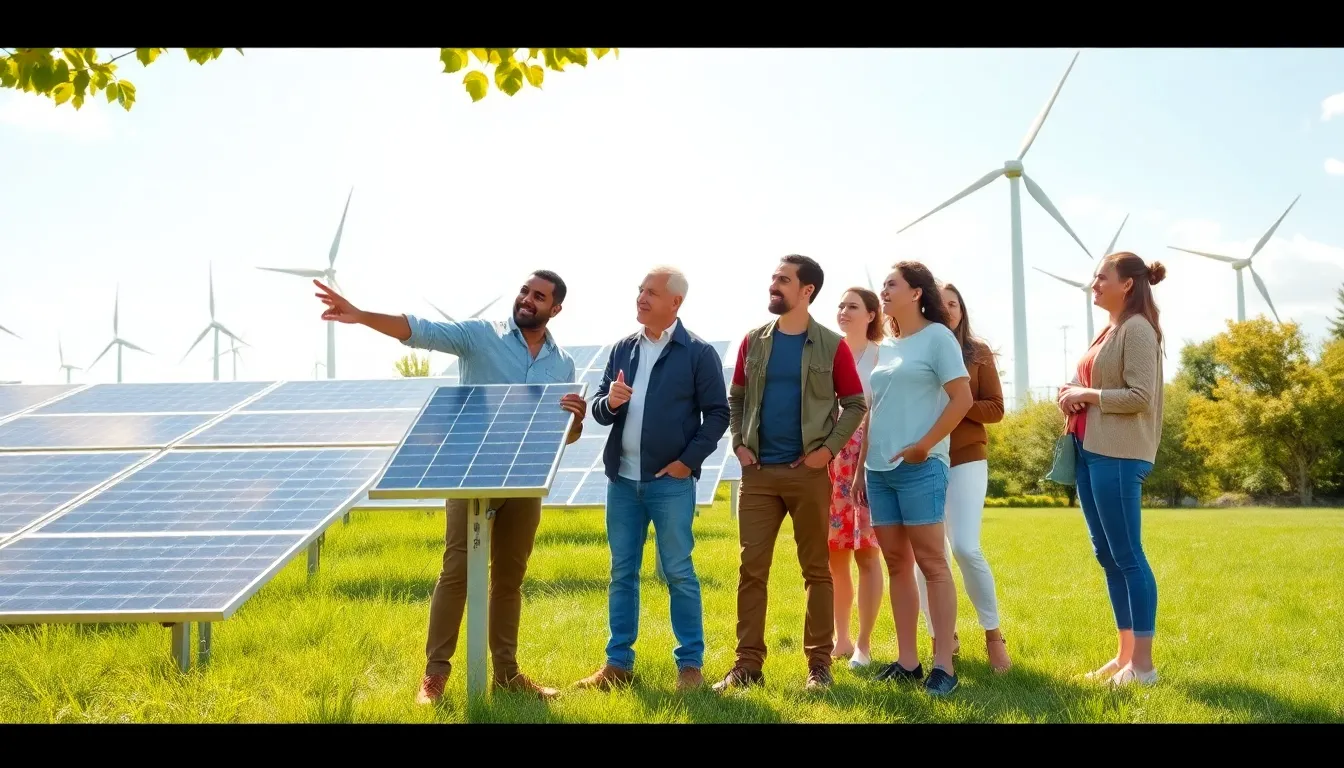Sustainable living isn’t just a trend; it’s the future waving at us with a reusable shopping bag. As the planet warms up faster than a cup of coffee left in the sun, innovative solutions are popping up like mushrooms after a rainstorm. From solar panels that double as art to smart homes that practically run themselves, these advancements make eco-friendly living not only possible but downright exciting.
Table of Contents
ToggleOverview of Sustainable Living Innovations
Sustainable living innovations focus on creating solutions that reduce environmental impact while improving quality of life. Advanced technologies now prioritize energy efficiency and renewable resources. For example, artistic solar panels not only generate clean energy but also serve as eye-catching designs for homes.
Smart homes utilize interconnected devices to optimize energy consumption. These systems allow users to monitor and control appliances remotely, resulting in lower energy bills and reduced carbon footprints. Innovations in sustainable materials, like bio-based plastics, contribute to lower waste and resource recovery.
Urban gardening represents another prominent trend. Individuals convert rooftops and balconies into green spaces, fostering local food production and improving air quality. Vertical gardens allow for efficient use of smaller areas, making gardening accessible regardless of space constraints.
Electric vehicles (EVs) lead the shift toward sustainable transportation. With the expansion of charging stations, more people choose EVs for their lower emissions and long-term cost savings. Additionally, bike-sharing programs in cities promote eco-friendly commuting options.
Waste management has transformed due to innovative recycling technologies. Advanced sorting systems increase recycling rates, while composting initiatives reduce landfill contributions. Waste-to-energy plants convert non-recyclable waste into electricity, further supporting sustainable development.
Sustainable living innovations encapsulate a wide range of advancements that address environmental challenges. These inventions not only facilitate a greener lifestyle but also demonstrate the potential for societal change through technology and innovation.
Technological Innovations

Sustainable living relies heavily on technological innovations that drive energy efficiency and eco-friendly practices. These advancements play a crucial role in reducing environmental impact while enhancing quality of life.
Renewable Energy Solutions
Solar panels, wind turbines, and geothermal systems showcase the shift towards renewable energy solutions. These technologies harness natural resources to generate electricity, often at lower costs than traditional energy sources. For instance, solar energy can lead to an average savings of $1,500 annually on energy bills for homeowners. Wind farms, increasingly common in rural areas, provide a sustainable power source, some generating enough electricity for thousands of homes. Geothermal energy utilizes ground heat, offering a reliable and constant energy output with minimal environmental disruption. Each of these solutions contributes to a cleaner energy landscape, promoting sustainable practices across various sectors.
Eco-Friendly Materials
Novel eco-friendly materials significantly reduce the environmental footprint of products. Biodegradable plastics, made from natural substances like cornstarch, decompose within months, unlike petroleum-based plastics that linger for centuries. Homes constructed from sustainable materials, such as bamboo or reclaimed wood, not only minimize waste but also provide durable structures. Additionally, innovations in textile production, like organic cotton or recycled synthetics, push the fashion industry toward sustainability. Each of these materials emphasizes the importance of responsible sourcing and production processes, fostering a greener future in construction and consumer goods.
Urban Gardening and Farming
Urban gardening and farming play a significant role in sustainable living innovations. These practices enhance local food production and improve air quality in densely populated areas.
Vertical Farming Techniques
Vertical farming techniques maximize limited urban space by utilizing stacked layers for plant growth. This method enhances crop yield while minimizing land use. Hydroponic and aeroponic systems often accompany these techniques, allowing plants to grow in nutrient-rich solutions without soil. Data from the U.S. Department of Agriculture indicates a 10-times increase in crop production per square foot compared to traditional farming. Increased energy efficiency also characterizes vertical farms, which frequently incorporate LED lighting to promote plant growth. These innovative systems help cities meet food demands sustainably, reducing the carbon footprint of transportation and lowering reliance on conventional agriculture.
Community Supported Agriculture
Community Supported Agriculture (CSA) connects consumers directly with local farmers. Members subscribe to receive fresh, seasonal produce while supporting local economies. This model fosters a sense of community and encourages a sustainable local food system. Studies show that CSAs can reduce carbon emissions by up to 50% compared to grocery store produce due to shorter supply chains. Members often participate in farm activities, enhancing their understanding of sustainable farming practices. This involvement strengthens community ties and promotes healthy eating habits among participants. By boosting local agricultural production, CSAs contribute significantly to urban gardening initiatives and sustainable living.
Waste Reduction Strategies
Waste reduction strategies play a vital role in promoting sustainable living. Innovations in both upcycling and composting actively contribute to minimizing waste and fostering environmental responsibility.
Upcycling and Recycling Innovations
Upcycling involves transforming discarded items into new products with added value. This practice not only prevents waste but also inspires creativity in individual communities. Recently developed recycling technologies enhance the efficiency and effectiveness of recycling processes. For instance, automated sorting systems increase material recovery rates by up to 30%, ensuring more materials enter the recycling stream. Innovative companies are creating products from recycled plastics and metals that reduce the need for virgin materials. Engaging local artisans in upcycling projects fosters community involvement and demonstrates the potential of reimagined materials.
Composting Systems
Composting systems convert organic waste into nutrient-rich soil amendments. These systems effectively divert food scraps and yard waste from landfills, reducing methane emissions significantly. With composting, cities can decrease waste sent to landfills by up to 30%, creating valuable resources for urban gardens and farms. Commercial composting facilities use advanced technology to process larger quantities safely, providing a sustainable solution for municipalities. Home composting systems are also becoming popular, empowering individuals to contribute to waste reduction while enriching their gardens. Educational programs promote awareness of composting benefits and encourage community participation in sustainable practices.
Sustainable Transportation Options
Sustainable transportation options play a crucial role in reducing carbon emissions and promoting a cleaner environment. Electric vehicles (EVs) and hybrid vehicles are essential components of this shift.
Electric and Hybrid Vehicles
Electric vehicles offer zero tailpipe emissions, making them a cleaner choice for urban commuting. More EV models are available than ever, catering to diverse consumer needs and preferences. For instance, several automakers report significant increases in sales, with EV sales reaching over 600,000 units in 2022 alone. Hybrid vehicles, combining electric and gasoline engines, provide an excellent compromise, delivering better fuel efficiency while reducing dependency on fossil fuels. Charging infrastructure continues expanding, with over 100,000 public charging stations installed throughout the US. This convenience encourages adoption as drivers can easily access charging options.
Public Transit Innovations
Public transit innovations are vital for promoting sustainable commuting. Cities have implemented smart transit systems that incorporate real-time tracking and mobile ticketing, improving user experience. Buses powered by electricity or alternative fuels emerge as cleaner options, reducing emissions and fostering energy independence. For example, some cities have introduced electric bus fleets, resulting in up to 70% lower greenhouse gas emissions compared to traditional diesel buses. Bike-sharing programs also gain popularity, with cities reporting a 30% increase in bike usage over the past five years. These measures encourage communities to embrace public transit, ultimately leading to fewer vehicles on the road and enhanced air quality.
Sustainable living innovations are paving the way for a brighter future. By embracing technology and creativity, individuals and communities can significantly reduce their environmental impact while enhancing their quality of life.
From smart homes to urban gardening and electric vehicles, these advancements not only address pressing climate issues but also inspire a collective movement towards sustainability.
As awareness grows and more people adopt these practices, the potential for positive change becomes limitless. The journey toward a sustainable lifestyle is not just necessary; it’s an exciting opportunity for innovation and community engagement.


